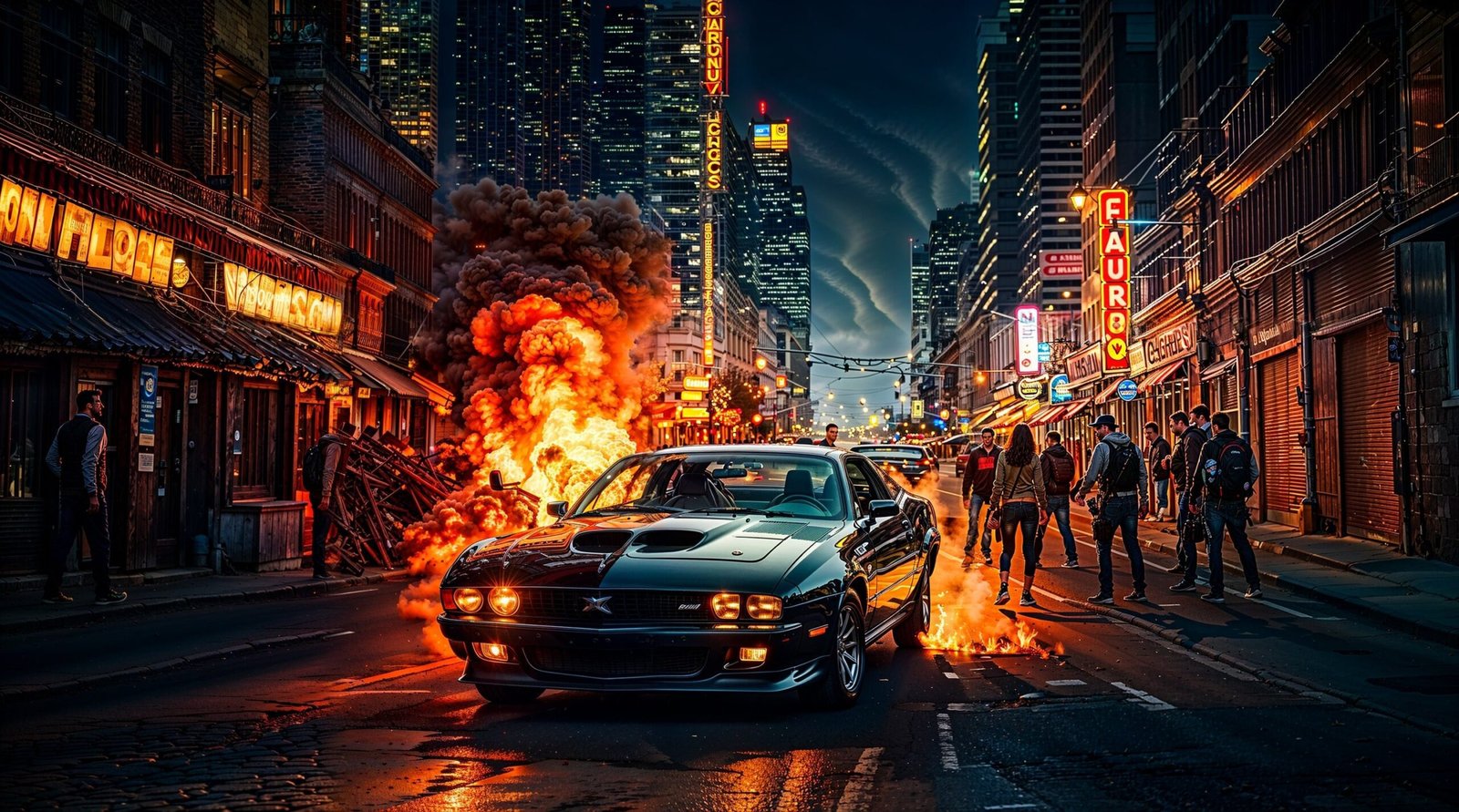The Fast & Furious saga kicked off in 2001 amid the street-racing subculture but has since grown into a globe-spanning blockbuster phenomenon. What began as a modest car-heist flick evolved into a saga fueled by high-octane thrills, emotional depth, and the enduring theme of chosen family (The Guardian).
- Acting & Casting in the Fast & Furious Universe
- Direction & Writing: Behind the Scenes of Fast & Furious Storytelling
- Cinematography & Visual Style in Fast & Furious Movies
- Fast & Furious Themes: Family, Loyalty, and Global Identity
- Evolution & Reception of the Fast & Furious Movie Series
- The Fast and the Furious (2001) – Rating: 55%
- 2 Fast 2 Furious (2003) – Rating: 37%
- Tokyo Drift (2006) – Rating: 38%
- Fast & Furious (2009) – Rating: 29%
- Fast Five (2011) – Rating: 78%
- Fast & Furious 6 (2013) – Rating: 71%
- Furious 7 (2015) – Rating: 82%
- The Fate of the Furious (2017) – Rating: 67%
- F9 (2021) – Rating: 59%
- Hobbs & Shaw – The Spin-off That Defied Gravity and Genre
- Fast X (2023) – Rating: 57%
- Final Lap Forecast – Predicting the Fast & Furious 11 Finale
- Final Verdict – Why the Fast & Furious Franchise Still Matters
Acting & Casting in the Fast & Furious Universe
From Paul Walker’s understated sincerity as Brian O’Conner to Vin Diesel’s steely dominance as Dom Toretto, the core cast delivers an anchor of emotional authenticity. The tragic passing of Walker was integrated into Furious 7 with real emotional weight, earning it critical praise for its tribute and resonance (Wikipedia). Sung Kang’s Han—a character first introduced in Tokyo Drift—grew into a fan favorite, so much so that his return in F9 felt deeply earned and emotionally satisfying (GQ).
Direction & Writing: Behind the Scenes of Fast & Furious Storytelling
While the early films were street-racing crime dramas, Fast Five (2011) marked the franchise’s reinvention as a fully-fledged action-heist series, showcasing director Justin Lin’s bold shift away from racing toward cinematic spectacle and ensemble storytelling (Wikipedia). (Furious 7) continued that upward trajectory, despite tragedy, blending ramped-up stakes with surprisingly grounded emotional arcs (Wikipedia). Critics have likened the franchise to a D&D campaign—characters grow tighter, stakes escalate, and narratives push ever more ridiculous boundaries (Vox).
Cinematography & Visual Style in Fast & Furious Movies
The visual style has matched the films’ tonal metamorphoses: early gritty, grounded lighting gives way to glossy, explosive set-pieces across diverse cities and countries. TP Lin’s direction keeps stunts largely practical—up to Fast Five—giving scenes a visceral, lived-in feel even amid jaw-dropping gravity-defying moments (Wikipedia).
Fast & Furious Themes: Family, Loyalty, and Global Identity
At its core, Fast & Furious is about family—specifically, loyalty among a chosen tribe rather than blood relations. That mantra became foregrounded not just in dialogue but in casting, storytelling, and even real-life gestures: Diesel naming his daughter “Paulina” and the cultural handling of Walker’s loss reveal the franchise’s outsize emotional undercurrent (Medium). Despite its hypermasculine aesthetic, the franchise has cultivated a diverse, inclusive world that resonates across identities, even becoming a surprising queer-iconic text for some fans (The Guardian).
Evolution & Reception of the Fast & Furious Movie Series
- The Fast and the Furious (2001): Modest beginnings—street racing, undercover drama—mixed critical interest with cult appeal (People.com).
- Fast Five – a turning point: Heist-driven, big-scale action; widely considered the best of the series, both critically and commercially (earning over $626M worldwide) (Wikipedia).
- Furious 7 (2015): Emotional high watermark—with the franchise’s highest Rotten Tomatoes score and box-office record at the time—cemented by its sensitive tribute to Walker (Wikipedia).
- Fast & Furious 6: Refined the winning formula with humor, ensemble chemistry, and kinetic spectacle (~71% RT score) (Wikipedia).
- Later chapters (The Fate of the Furious, F9, Fast X) grew ever more extravagant and polarizing—visually audacious but sometimes narratively uneven. Still, The Fate of the Furious surpassed $1.2B globally, proving the saga’s unstoppable global appeal (Wikipedia).
The Fast and the Furious (2001) – Rating: 55%
The opener introduces Brian O’Conner (Paul Walker) undercover in LA’s street-racing scene, clashing with Dominic Toretto (Vin Diesel). At its core, this is a raw crime‑thriller draped in adolescent cool—but it cleverly lays the foundation for loyalty and identity that the series would build upon. Despite mixed reviews, the chemistry between the leads and its authentic racing milieu give it undeniable charm (Reddit).
Critically, the film was fair: praised for its gritty energy but faulted for thin storytelling and limited character depth. It works best as a time capsule of early 2000s car‐culture style—a spark, rather than a polished engine (Wikipedia, Rotten Tomatoes).
2 Fast 2 Furious (2003) – Rating: 37%
Without Vin Diesel, this Miami‑set sequel leans into slick visuals and big personalities—Tyrese Gibson, Ludacris, and Eva Mendes—but lacks the emotional anchor of Dom. Brian’s fun-loving swagger powers scenes, but the absence of franchise heft makes it feel more lightweight spin than evolution (Wikipedia, Wikipedia).
Pleasing enough for action fans, but critics flagged it as style over substance. It’s enjoyable in bursts, but rarely resonates beyond flashy sequences and moments of comic relief (Wikipedia).
Tokyo Drift (2006) – Rating: 38%
A tonal shift and a new setting—Tokyo—this instalment centers on Sean Boswell’s immersion in drifting culture. Initially an odd standalone entry, it gained significance later as Han’s origin story. Visually sleek and culturally interesting, but emotionally distant without core characters (People.com).
Critics saw it as lacking narrative weight, but audiences (and later interconnections) gave it cult respect. In context, it’s foundational—but still a less compelling film on its own (Wikipedia, EW.com).
Fast & Furious (2009) – Rating: 29%
Bringing Dom and Brian back together, this revival-toned fourth film is dark, vengeance-driven, and emotionally weighty. Letty’s apparent death and returning characters stiffen the stakes—but critics criticized its stodgy pace and underplayed plot (Wikipedia, Wikipedia).
Though structurally important, it lacks the spark of earlier entries and gets little forgiveness for a gritty tone that sometimes feels joyless. Its value comes from setup, not execution (EW.com, Wikipedia).
Fast Five (2011) – Rating: 78%
The franchise reinvention film: a Rio‑set heist with Team Toretto vs. a corrupt mogul, featuring Dwayne Johnson’s Hobbs. It blends humor, character chemistry, and set‑piece action. A turning point that delivered blockbuster spectacle grounded in team emotions (Wikipedia, Wikipedia).
Critics and fans loved it for its cohesiveness and entertainment value. More than just fast cars—this is the movie where Fast & Furious became a global juggernaut (Radio Times).
Fast & Furious 6 (2013) – Rating: 71%
Picking up immediately after Fast Five, this film reassembles the family to take on a terrorist threat. It balances international espionage with personal reckoning—Letty alive, stakes higher. Stellar ensemble work and tighter pacing make it a satisfying follow‑up (Wikipedia, Wikipedia).
Critics appreciated its blend of emotion and energy: fun, knowing, and rich in character momentum. It doesn’t reinvent, but it refines what worked in Five (Wikipedia).
Furious 7 (2015) – Rating: 82%
A tribute turned triumph. Following Paul Walker’s real-life death, Furious 7 became unexpectedly heartfelt. Over-the-top stunts meet emotional closure—especially the “See You Again” scene. It balances grief and adrenaline with maturity (Wikipedia).
Critics hailed it as one of the best—not just for action, but for honoring loss with grace. A peak in both box office and emotional resonance that grounded the franchise (Wikipedia, Wikipedia).
The Fate of the Furious (2017) – Rating: 67%
Dom turns on his family under ransom by a cyber‑terrorist Cipher (Charlize Theron)—a bold but divisive choice. The action is big, the cast is stacked, and the globe‑trotting missions are lavish. But storytelling coherence takes a hit in exchange for ambition (Wikipedia).
Critics praised individual cast chemistry and spectacle, but struggled with tonal drift and narrative leaps. Still massively successful at box office, it carries emotional weight while sacrificing clarity (Wikipedia, EW.com).
F9 (2021) – Rating: 59%
Dom faces his estranged brother Jakob (John Cena) in a mix of family backstory and cosmic‑grade action—cars in space included. Its stunts are fearless and ambitious, but narrative logic and stakes can feel cartoonish. Energetic, occasionally brilliant, but more spectacle than substance (Wikipedia, Wikipedia).
Critics praised visuals and direction but criticized the thinness of plot and character arcs. For fans craving spectacle, it delivers—just don’t expect grounded storytelling (Wikipedia, EW.com).
Hobbs & Shaw – The Spin-off That Defied Gravity and Genre
Fast & Furious Presents: Hobbs & Shaw (2019) took two of the franchise’s most charismatic supporting players—Dwayne Johnson’s gruff, rule-breaking Luke Hobbs and Jason Statham’s cool, deadly Deckard Shaw—and threw them into their own buddy-action mayhem. Directed by David Leitch (John Wick, Deadpool 2), the film feels more like a superhero movie than a street-level heist: think genetically enhanced villains, a globe-trotting plot, and skyscraper-sized explosions.
What it lacks in emotional grounding, it compensates for with sheer charm and spectacle. The chemistry between Johnson and Statham is electric, with punchlines landing almost as hard as the punches. While its ties to the main saga feel loose, Hobbs & Shaw succeeds on its own terms: as a slick, self-aware crowd-pleaser. If the finale finds a way to re-integrate these characters meaningfully, the saga might go out not just with a bang—but a smile.
Fast X (2023) – Rating: 57%
Dom’s team up against new villain Dante Reyes (Jason Momoa) in what feels like a building block toward a franchise finale. With a colossal budget ($378M+), international locations, and sprawling scale, it’s ambitious—but critics flagged inconsistent tone and convoluted writing (Wikipedia).
Where it succeeds visually and climactically, it stumbles narratively. Momoa’s presence and action sequences elevate it beyond mere spectacle, but the story’s broad strokes feel overtaxed (Wikipedia, EW.com).
Final Lap Forecast – Predicting the Fast & Furious 11 Finale
With Fast & Furious 11 announced as the last full-chapter entry in the saga, expectations are sky-high—but so is the pressure. This isn’t just another street race or globe-spanning mission. It’s a swan song. And with a cast as iconic (and sprawling) as this one, the emotional and cinematic stakes couldn’t be higher.
🎬 Cast & Crew: Who’s Steering the Finale?
- Vin Diesel (Dominic Toretto): The spiritual and literal driver of the franchise, Diesel’s leadership will be crucial in anchoring the narrative with gravitas, grief, and that gravel-voiced intensity only he can deliver.
- Michelle Rodriguez (Letty Ortiz): Rodriguez remains the franchise’s emotional core and combat heartbeat. Her bond with Dom and evolution as a character should be front and center.
- Tyrese Gibson & Ludacris (Roman & Tej): Expect more comic relief—but hopefully with deeper stakes. Their friendship needs emotional closure, not just quips.
- Jordana Brewster (Mia Toretto): With Brian’s legacy ever-present, Mia’s role will likely serve as the connective tissue to Paul Walker’s spirit—one of the finale’s most delicate tasks.
- Jason Momoa (Dante Reyes): Returning as the flamboyant, unhinged villain from Fast X, Momoa could make or break the finale’s tone. His performance walks a fine line between inspired chaos and tonal distraction.
- Charlize Theron (Cipher): If Cipher survives her fate in Fast X, she may either redeem herself or burn out as the final boss. Her character’s arc needs resolution.
- Director: Louis Leterrier (Fast X) is returning. While his style delivered scale, the finale’s success will hinge on whether he can trim excess and lean into emotional storytelling, not just gravity-defying set-pieces.
- Writers: Justin Lin and Dan Mazeau are expected to shape the script. Lin’s history with the franchise offers hope that he can close the loop on character arcs and storylines with emotional logic and explosive payoff.
Projected Scorecard for Fast & Furious 11
| Category | Projected Score |
|---|---|
| Story & Writing | 6.5 |
| Direction & Pacing | 7.0 |
| Performance & Chemistry | 8.0 |
| Action & Spectacle | 8.5 |
| Emotional/Franchise Impact | 9.0 |
| Projected Average | 7.69/10 |
If these creative forces align—melding nostalgia, narrative closure, and spectacle—the final installment could be one of the franchise’s most cathartic rides. Not perfect, but deeply Fast & Furious: part opera, part joyride, part goodbye.
Final Verdict – Why the Fast & Furious Franchise Still Matters
The Fast & Furious saga started small and chaotic, but evolved into one of Hollywood’s most unapologetically joyful blockbusters—cars in space, actors smashing through realism, yet grounded in its emotional core. It’s absurd, yes—but absurd with purpose: loyalty, found family, and kinetic spectacle that refuses to apologize for its highs.
Who it’s for: If you crave unabashed adrenaline, emotional through-lines, and cast camaraderie that survives even death—and maybe suspension of disbelief so high it loops around—you’ll find the Fast Saga exhilarating.
Sure, the plots sometimes feel ludicrous, but the ride is reliably entertaining—and deeply human underneath the crash helmets. A guilty joy? More like a beloved cultural juggernaut.





